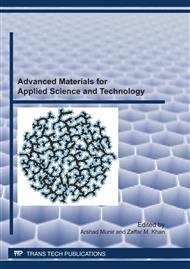[1]
Thomson. T., Polyurethanes as Specialty Chemicals, Principles and Applications, New York: CRC Press, (2000).
Google Scholar
[2]
Keith D. W., Paint & Coatings: A Mature Industry in Transition, Prog. Polym. Sci., Vol. 22, 203-245, (1991).
Google Scholar
[3]
Kueir-Rarn. L, Min-Yu. T, Tsung-Neng. H, Juin-Yih. L., A Study on Pervaporation of Aqueous Ethanol Solution by Modified Polyurethane Membrane, Journal of Membrane Science 162 (1999) 173-180.
DOI: 10.1016/s0376-7388(99)00136-2
Google Scholar
[4]
Chattopadhyay. D. K, Raju K.V.S.N., Structural Engineering of Polyurethane Coatings for High Performance Applications, Prog. Polym. Sci. 32 (2007) 352–418.
DOI: 10.1016/j.progpolymsci.2006.05.003
Google Scholar
[5]
Keyur P. S, Sujata S. K, Natvar K. P, Animesh K. R, Castor Oil Based Polyurethane Adhesives for Wood-To-Wood Bonding., International Journal of Adhesion & Adhesives 23 (2003) 269–275.
DOI: 10.1016/s0143-7496(03)00044-7
Google Scholar
[6]
Hamid. Y, Mohammad R. M., Synthesis and Properties of Isocyanate Curable Millable Polyurethane Elastomers Based on Castor Oil as a Renewable Resource Polyol., European Polymer Journal 40 (2004) 1233–1238.
DOI: 10.1016/j.eurpolymj.2003.12.013
Google Scholar
[7]
Giulio. M, Aldo. P, Franco. F, Andrea. Q, Mariaenrica. F, Cosimo. C., Polyurethane resin-based adhesives: Curing Reaction and Properties of Cured Systems, International Journal of Adhesion & Adhesives 25 (2005) 87–91.
DOI: 10.1016/j.ijadhadh.2004.04.003
Google Scholar
[8]
Yuen. K. T, Sylwester. G., Microporous Biodegradable Polyurethane Membranes for Tissue Engineering., J Mater Sci: Mater Med (2009) 20: 1729–1741.
DOI: 10.1007/s10856-009-3722-4
Google Scholar
[9]
Michael. S., Handbook of Polyurethanes, CRC, (1999).
Google Scholar
[10]
Khan M.B., in Handbook of Engineering Polymeric Materials, N.P. Cheremisinoff, Ed., Marcel Dekker, N.Y. (1997) p.705.
Google Scholar
[11]
Jorg. M and Hans. S., Military High Explosives, CHIMIA, 58, No. 6, (2004).
Google Scholar
[12]
Alian. D., Solid Rocket Propulsion Technology, Pergamon Press, (1993).
Google Scholar
[13]
Khan M.B., Intelligent Viscoelastic Polyurethane Intrinsic Nanocomposites, The Minerals, Metals & Materials Society and ASM International (2010).
Google Scholar
[14]
Khan M.B., SEM Comparison of Traditional & Modulus Gradient-Induced Particulate Composites of Polyurethane Nano Polymer, The Nucleus 44(3-4) (2007).
Google Scholar
[15]
Mayo S., Manufacture of Plastics, Reinhold publishing, N. Y, vol. 1, (1964).
Google Scholar
[16]
Dzierza. W, Mechanical Properties of Crosslinked Polyurethanes, J Appl Polym Sci 1978; 22: 1331–42.
Google Scholar
[17]
Cuvé. L, Pascault, J. P., Boiteux, G. & Seytre, G., Polymer, 32 (1991) 343.
Google Scholar
[18]
Sonal D, Thakore I. M, Sarawade B. D, Surekha D., Effect of Polyols & Diisocyanates on Thermo-Mechanical & Morphological Properties of Polyurethanes, European Polymer Journal 36 (2000) 711-725.
DOI: 10.1016/s0014-3057(99)00114-7
Google Scholar
[19]
Ulrich T., Energetic Materials, Particle Processing and Characterization, Wiley-VCH, (2005).
Google Scholar
[20]
Carina E, Ng Hsiao Y, Marita. W and Niklas W., A Method of Determining Processing Behavior of Plastic Bounded Propellants and Explosives, Annual Transactions of the Nordic Rheology Society, Vol. 12, (2004).
Google Scholar
[21]
Mihail I., Chemistry and Technology of Polyols for Polyurethanes, Rapra Technology, 2005. P-444.
Google Scholar
[22]
Shih-Liang H And Juin-Yih L., Structure-Tensile Properties of Polyurethanes, Eur. Polym. J. Vol. 33, No. 10-12, pp.1563-1567, (1997).
Google Scholar
[23]
Li. S, Vatanparast. R, Lemmethyinen H., Cross-Linking Kinetics and Swelling Behaviour of Aliphatic Polyurethane, Polymer 41 (2000) 5571-5576.
DOI: 10.1016/s0032-3861(99)00785-5
Google Scholar


